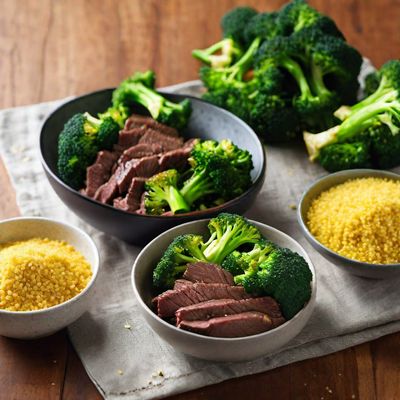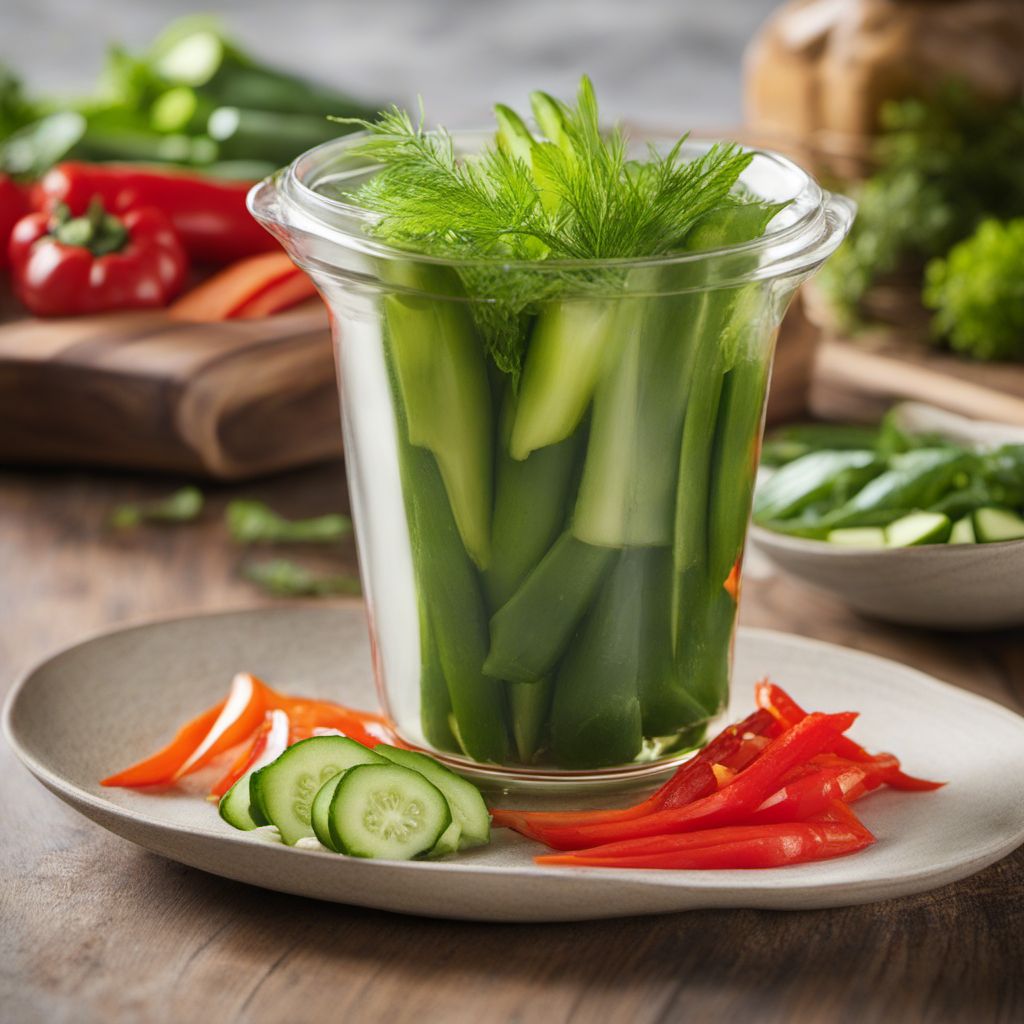
Recipe
Swabian-style Pickled Vegetables
Tangy Swabian Delight: Pickled Vegetables with a German Twist
4.7 out of 5
Indulge in the flavors of Swabian cuisine with this delightful recipe for pickled vegetables. Inspired by the traditional Japanese dish Matsumaezuke, this Swabian adaptation brings a unique twist to the tangy and crunchy goodness of pickled vegetables.
Metadata
Preparation time
15 minutes
Cooking time
2 minutes
Total time
17 minutes (plus 24 hours for pickling)
Yields
4 servings
Preparation difficulty
Easy
Suitable for
Vegetarian, Vegan, Gluten-free, Dairy-free, Low calorie
Allergens
N/A
Not suitable for
Paleo, Keto, Low-carb, Nut-free, Soy-free
Ingredients
In this Swabian adaptation, the traditional Japanese Matsumaezuke is transformed into a German-inspired pickled vegetable dish. The original recipe typically includes ingredients like daikon radish, lotus root, and soy sauce, which are replaced with locally available vegetables such as cucumbers, carrots, and bell peppers. The brine is also infused with German spices and herbs, giving it a distinct flavor profile that complements Swabian cuisine. We alse have the original recipe for Matsumaezuke, so you can check it out.
-
2 cucumbers, thinly sliced (300g) 2 cucumbers, thinly sliced (300g)
-
2 carrots, julienned (200g) 2 carrots, julienned (200g)
-
1 red bell pepper, thinly sliced (150g) 1 red bell pepper, thinly sliced (150g)
-
1 yellow bell pepper, thinly sliced (150g) 1 yellow bell pepper, thinly sliced (150g)
-
1 green bell pepper, thinly sliced (150g) 1 green bell pepper, thinly sliced (150g)
-
1 onion, thinly sliced (100g) 1 onion, thinly sliced (100g)
-
2 cups (470ml) white vinegar 2 cups (470ml) white vinegar
-
1 cup (235ml) water 1 cup (235ml) water
-
1/4 cup (50g) granulated sugar 1/4 cup (50g) granulated sugar
-
2 teaspoons mustard seeds 2 teaspoons mustard seeds
-
1 teaspoon dill seeds 1 teaspoon dill seeds
-
1 teaspoon black peppercorns 1 teaspoon black peppercorns
-
1 teaspoon salt 1 teaspoon salt
Nutrition
- Calories (kcal / KJ): 80 kcal / 335 KJ
- Fat (total, saturated): 0g, 0g
- Carbohydrates (total, sugars): 19g, 14g
- Protein: 2g
- Fiber: 4g
- Salt: 1.5g
Preparation
-
1.In a large saucepan, combine the white vinegar, water, sugar, mustard seeds, dill seeds, black peppercorns, and salt. Bring the mixture to a boil over medium heat, stirring until the sugar and salt dissolve.
-
2.Add the sliced cucumbers, carrots, bell peppers, and onion to the boiling brine. Cook for 2 minutes, then remove from heat.
-
3.Allow the mixture to cool to room temperature, then transfer it to a sterilized jar or container. Make sure the vegetables are fully submerged in the brine.
-
4.Cover the jar or container tightly and refrigerate for at least 24 hours before serving. The pickled vegetables can be stored in the refrigerator for up to 2 weeks.
Treat your ingredients with care...
- Cucumbers — Use fresh and firm cucumbers for the best texture in the pickled vegetables.
- Mustard seeds — Toasting the mustard seeds before adding them to the brine can enhance their flavor.
- Bell peppers — Choose bell peppers that are vibrant in color and free from blemishes for the most appealing pickled vegetables.
Tips & Tricks
- For a spicier version, add a sliced chili pepper to the brine.
- Experiment with different vegetables such as cauliflower or radishes for variety.
- Serve the pickled vegetables alongside traditional Swabian dishes like Maultaschen or Spätzle.
- Adjust the sweetness and tanginess of the brine by adding more or less sugar and vinegar, according to your taste preference.
- To enhance the flavors, let the pickled vegetables marinate in the refrigerator for a few days before serving.
Serving advice
Serve the Swabian-style Pickled Vegetables as a refreshing side dish alongside hearty German meals. They also make a great addition to sandwiches, wraps, or salads, adding a burst of tangy flavor and crunch.
Presentation advice
Arrange the colorful pickled vegetables in a glass jar or on a serving platter to showcase their vibrant hues. Garnish with fresh dill or parsley for an extra touch of freshness.
More recipes...
For Matsumaezuke
For Japanese cuisine » Browse all
For Swabian cuisine » Browse all

Swabian Goro - Traditional German Waffle Cookies
Crispy Delights: Swabian Goro - German Waffle Cookies with a Twist

Swabian-Style Birmingham Balti
Savory Swabian Twist: Birmingham Balti with a German Flair
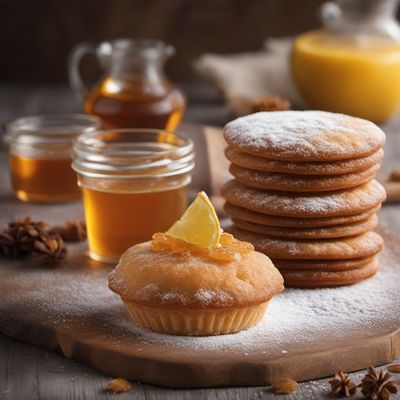
Hurmašica - Swabian Style Honey Pastries
Sweet Delights: Swabian Honey Pastries with a Bosnian Twist
More Japanese cuisine dishes » Browse all
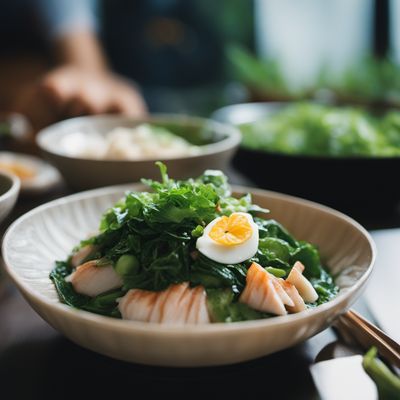
Ohitashi
Ohitashi is a traditional Japanese dish made with leafy greens. It is a light and refreshing dish that is perfect for hot summer days.

Natto Curry
Natto curry
Natto Curry is a Japanese dish that is made with fermented soybeans and a spicy curry sauce. It is known for its unique and bold flavors.
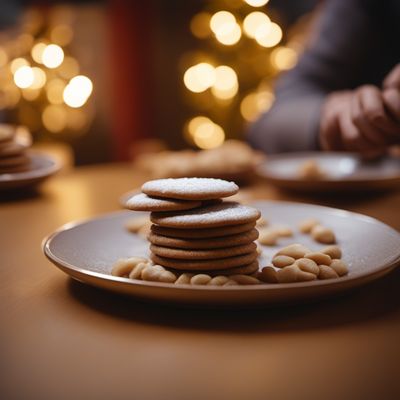
Goro
Goro is a traditional Norwegian cookie that is often served during Christmas time. It is a thin, crispy cookie that is shaped like a diamond.


